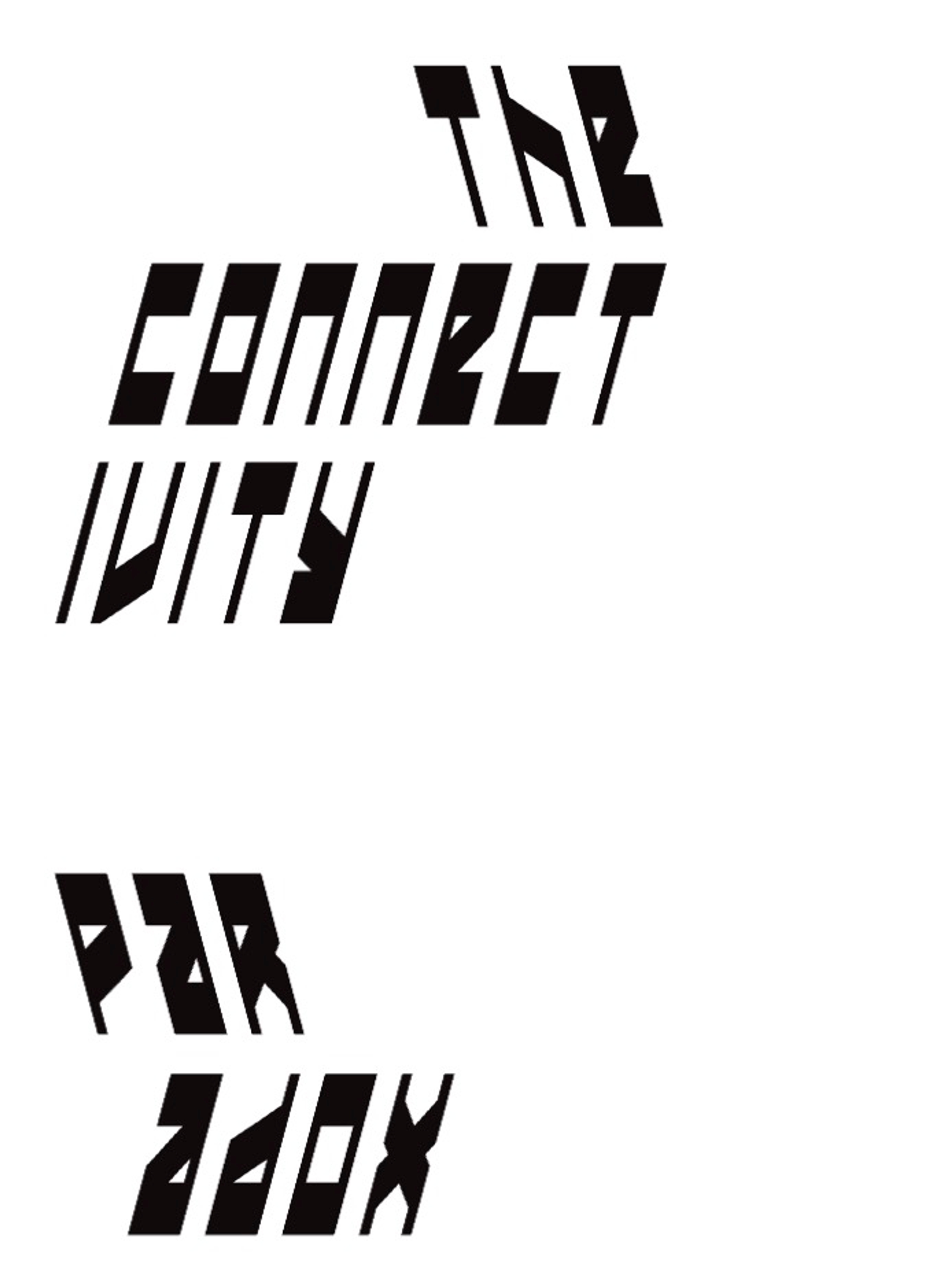THE CONNECTIVITY PARADOX


THE CONNECTIVITY PARADOX
Words: 2715
Estimated reading time: 15M
IN THE DIGITAL AGE, HUMAN CONNECTION IS OFTEN ECLIPSED BY ITS PROJECTION. HOW CAN WE CULTIVATE MEANINGFUL RELATIONSHIPS?
By Christopher Michael
During a recent visit to a downtown hotspot—the kind of place where the price of a meal signals status as much as the dish itself—I watched as two young women, illuminated by the blinding light of a small but professional piece of equipment, meticulously framed content at their table. An iPhone stood at attention, a silent witness to their efforts. Glancing around, I anticipated disapproving looks from fellow diners or the swift intervention of a staff member who might politely remind them that dinner is, in theory, a sensory experience. But no one seemed to notice, let alone care. This scene triggered an inevitable spiral: Wasn’t the internet once a place of discovery rather than display? How often do we witness, in real time, people forfeiting presence for performance? The curated moment taking precedence over the lived one? The idea of experience elevated above the reality of it? In an era where connection is increasingly performative, where attention is divided between the immediate and the projected, an existential dilemma—neatly packaged in the glow of a ring light—has emerged.
It wasn’t always this way. As a millennial of a certain age, I can still recall the ritual of sneaking down to the basement after everyone had gone to bed, holding my breath as the dial-up modem screeched to life, praying it wouldn’t wake the house. The internet was a slow-moving frontier then—pages loading at a glacial pace, conversations with strangers stretching into dawn—but it felt like the start of something limitless. Connection was an act of seeking, not broadcasting. A portal to discovery, an open landscape where curiosity thrived, unbound by algorithmic oversight. The early 2000s promised digital freedom, but the arrival of smartphones and social media in the late 2000s changed everything. What began as a tool for connection quickly became a mechanism for performance. By 2016, metrics like engagement, visibility, and earned media value dictated cultural relevance, turning personal identity into a product and self-worth into a quantifiable statistic.
The shift wasn’t just psychological; it was physiological. Platforms optimized for consumption conditioned users to crave the constant validation of likes, shares, and follows. Instagram cultivated comparison culture, TikTok perfected the infinite dopamine loop, and Twitter distilled discourse down to soundbites. By the late 2010s, studies confirmed what many already felt: Anxiety, burnout, and digital fatigue were no longer exceptions but the norm.
Hyperconnectivity is a paradox. As it frays attention spans and erodes real-world presence, it remains indispensable—embedding itself in personal, professional, and creative spaces. Fashion, once dictated by editorial calendars and seasonal rhythms, is now in constant dialogue with the algorithm, where a viral moment can eclipse a full collection. Daniel Roseberry tackled the topic rather poignantly this season, remarking, “So much of the fashion we all love was not built for the internet; it was built for a very intimate moment, which feels like an untapped source of inspiration. I’d like to see less desperation and a bit more reserve.” As culture moves faster than ever, it also feels increasingly fragmented, its meaning diluted by the sheer volume of content.
The reckoning has already begun. Gen Z and Millennials are disengaging from “always-on” culture, favoring private circles over public feeds, long-form over disposable content, presence over projection. The rise of closed communities, invite-only platforms, and intentional consumption signals a quiet rebellion—a recalibration of digital life in search of something more tangible, more human.
There is no undoing hyperconnectivity, but there is an opportunity to reclaim agency within it. The question is no longer how we disconnect, but how we engage on our own terms, tipping the scales from visibility to value. Even as digital saturation breeds exhaustion, it has opened doors once firmly shut. The same hyperconnectivity that fractures attention spans has simultaneously dismantled hierarchies, democratizing access to influence, creativity, and commerce. Social media platforms have turned micro-movements into global phenomena, while independent creators, from designers to journalists, leverage digital tools to bypass legacy institutions, finding both community and financial autonomy. The rise of direct-to-consumer economies, from Substack to Depop, has empowered individuals to build their own brands, while digital activism has mobilized social change at unprecedented speed. Fashion, music, and art no longer trickle down from a singular elite but evolve in real time across continents, propelled by a hyper-engaged, borderless audience. Why, then, amidst all this connection, are we witnessing the continued spread of a loneliness epidemic?
Some years before the advent of social media, Robert Putnam’s Bowling Alone (2000) warned of an unraveling social fabric, as civic and community life gave way to individualism. The culprits? Suburban sprawl, television, and a culture increasingly structured around mobility rather than rootedness. Modern life, with its emphasis on productivity and self-sufficiency, has deprioritized the institutions that once fostered deep, communal ties. In the age of hustle culture, work—once a means to an end—is an identity. And consequently, relationships have become another casualty of our ever-expanding to-do lists.
It turns out, connection alone isn’t enough—the quality of that connection matters. The Harvard Study of Adult Development, which has tracked human well-being for over 85 years, confirms that happiness isn’t dictated by wealth or accolades, but by meaningful relationships. These findings underscore a fundamental truth: Humans are inherently social creatures. But if all connections are not created equal, what happens when digital interactions replace the nuanced, non-verbal forms of communication that have fostered long-lasting relationships for millennia? If traditional relationship structures no longer guarantee connection, what does?
Some are forging new models for community, like the seven thirtysomething Chinese women who built a shared retirement home in 2019. More than just a pragmatic housing solution, their decision was a statement—an intentional reimagining of what aging, companionship, and daily life could look like. Bound by decades of friendship, they envisioned a space where support was woven into the fabric of their existence, where the burdens and joys of growing older could be shared rather than shouldered alone. In doing so, they subtly yet powerfully challenged long-held assumptions about marriage and family, proving that, during a time of shifting societal norms, the most enduring commitments are not necessarily romantic.
While some are redefining connection through communal living and choosing lifelong friendships over conventional family structures, others have sought independence through mobility. The once impossible-to-ignore trend of the digital nomad gained significant momentum upon the onset of work-from-home culture born of the pandemic, prompting people to move abroad in droves. The allure of working from picturesque locations, unbeholden to the constraints of the traditional office, seemed like the ultimate expression of freedom and self-actualization. In the end, this lifestyle often came at a cost: a lack of stable community and a blurred line between work and personal life. Today, the pendulum seems to be swinging in reverse—not only due to back-to-office mandates, but also from a growing necessity to leave work at work, while retaining the opportunity to escape the once-aspirational silo.
At the heart of the matter is that the lived experience should take precedence over the performative one. Consider London’s oversaturation of DJs. People are no longer satisfied with simply existing in spaces; they must justify their presence by contributing to cultural conversation. The need to produce, rather than passively consume, now seems to define our sense of belonging. DJs uniquely embody this dynamic because their craft exists in direct dialogue with their audience. Every set is shaped in real time by the people on the dance floor. A similar shift has taken place in the culinary world, with Instagram chefs curating experiences that resonate in today’s fragmented social landscape, reflecting not only the evolving aesthetic preferences of certain age demographics, but the enduring appeal of intimate connection. The dinner table, after all, is a better setting for meaningful conversation than a crowded dance floor, but those who create real community wield powerful cultural currency.
The coolest people today aren’t just tastemakers, they’re exceptional hosts. They understand the alchemy of assembling the right mix of personalities, activities, and atmospheres to foster genuine connection. At a moment where only four percent of Americans spend time with friends on an average weekend, the ultimate luxury is not material but experiential—a Saturday night marked by great food, meaningful conversation, and genuine companionship. A notion that feels almost radical against the backdrop of meticulously curated, hyper-lit performances unfolding at that neighboring table.
Like any topic of the moment, the concept of community has been co-opted and commodified by brands, creators, and anyone who relies on marketing jargon to shape their strategy. But do they truly understand what it means in an era where follower counts have lost their cachet? Not all brands have lost the plot, though. Miu Miu and Loewe don’t just sell products; they’ve become masters of selling an experience, a world. Through carefully crafted storytelling, each brand curates a universe wherein its customers don’t just consume—they belong.
Building meaningful relationships requires more than just visibility; it hinges on crafting warm, intimate environments where people feel compelled to be present rather than perform. The new gold standard isn’t an event designed for maximum social reach—it’s a room where the goal isn’t to post, but to exist. The real challenge lies in translating this ethos offline, designing experiences that cater to hyper-specific niches, allowing people to revel in shared passions. If a community can vanish with the press of a button—like a TikTok account left dormant for a day—was it ever truly a community? How do we create conditions where belonging is not a passing trend, but a return to something lasting, something real?
With everything quite literally at our fingertips, easy access to that next hit of dopamine often deters people from going outside and engaging with real life. Instead, they opt to stream a concert, scroll through football highlights, or watch a live fashion show online, “participating” without the effort of physical presence. While this shift continues to democratize access to culture, it also risks diluting the richness of shared experience. Parasocial relationships, once associated with obsessive fans, have taken on new dimensions in today’s climate. With the excess of celebrity media, public figures can feel like part of our daily lives, generating a sense of intimacy that’s entirely one-sided. We hear their voices, see their curated moments, and consume their thoughts as though shared directly with us. Case in point: Andy Warhol, a master of disguise with a known habit of playing vapid, may have thrived in this new era of remote viewing, where there’s no need to attend life in person. “I’m the type who’d be happy not going anywhere as long as I was sure I knew exactly what was happening at the places I wasn’t going to,” he once said. Still, his frequently obsessive relationship with celebrities and beautiful people—so central to his artwork—would likely have suffered in a world experienced through a screen. His Factory was, after all, still a community.
Whether wandering the streets of Williamsburg or Shoreditch, it’s easy to mistake packed bars and overflowing restaurants for signs of intimacy rather than mere proximity. But, as the data suggests, it’s that quality, not quantity, is the true measure of belonging—a paradox that only deepens in a world where presence doesn’t always equate to closeness.
As we look to the future, it becomes clear that building meaningful connections is a matter of intentionality. It’s about creating spaces where people feel valued, understood, and connected to something larger than themselves. In the creative world, this means reimagining the ways we work and interact. Collaborative projects, cross-disciplinary partnerships, and inclusive platforms can help break down silos and foster unity. For brands, it’s about crafting narratives that resonate on a human level, inviting audiences to be part of their story rather than simply consume it. For individuals, it’s about nurturing relationships that inspire growth, creativity, and mutual support.
Whether through shared vision, the solidarity of a social movement, or the intimacy of a close friendship, our networks define us. They shape our experiences, influence our perspectives, and ultimately determine the legacy we leave behind. It might serve us to remember that our greatest wealth lies not in what we own but in the bonds we share, and the depth of presence that gives them meaning.
COLLAGE
DAVID JAMES
COLLAGE STILL LIFE PHOTOGRAPHER
ADRIEN DUBOST
Beyond Noise 2025
COLLAGE
DAVID JAMES
COLLAGE STILL LIFE PHOTOGRAPHER
ADRIEN DUBOST
Beyond Noise 2025
